Meet our experts
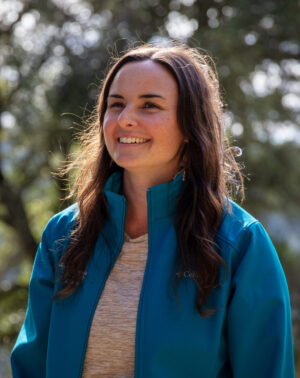
Adrianna Andreucci
Land Protection Manager II
Adrianna Andreucci grew up in Auburn, California in the foothills of the Sierra, but as a child, she spent many summers in the coast redwood forest of Humboldt Redwoods State Park with her father.
Read more »
Today, as land protection manager for Save the Redwoods League, she works directly to help protect those trees, guiding the sale of land and negotiating conservation easements between landowners and the League. She also interfaces with public agencies as the League transfers ownership of acquired properties to the National Park Service, Bureau of Land Management, United States Forest Service, and other agencies.
Andreucci earned her B.A. in Environmental Studies and Planning from Sonoma State in 2011. One of her positions after graduating was with the Greenbelt Alliance, an environmental advocacy group that promotes smart growth development and the preservation of open space. Andreucci joined the League in 2017, where she served as a conservation programs assistant & associate before moving into her current position in April 2021.
Andreucci appreciates the multi-faceted nature of her work, but she especially enjoys the special relationships she builds with landowners who have chosen to protect their land in perpetuity by selling it to the League or holding it in a conservation easement.
“Under the League’s ownership, we get to steward, manage, and nurture purchased property,” says Andreucci. “But partnering with landowners to keep land under their ownership—often lands that have been in a family for generations—while still making sure that sound management endures is really special.”
It’s a long-term relationship, and often the process can take years. Andreucci helps the League identify priority properties—redwood and giant sequoia lands with significant conservation value—but she also works with landowners who reach out directly.
This long-term impact is what drew Andreucci to her position. “I never thought I could have a career spending time in the places I love, doing work to ensure the protection of those places,” she says. “I can say after it’s done that this piece of land will be protected forever. It connects me to these places in a deeper way.”
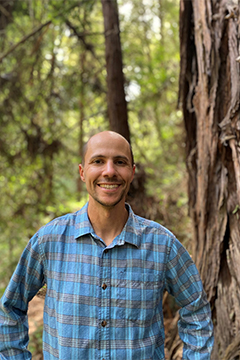
Ben Blom
Director of Stewardship and Restoration
With more than 15 years of restoration and forest management experience and a Master of Forestry from the Yale School of the Environment, Ben Blom serves as the League’s director of stewardship and restoration. He leads the League’s large-scale projects designed to rehabilitate California’s iconic coast redwood and giant sequoia forests. These include Redwoods Rising, which strives to restore tens of thousands of acres of historically clearcut forests in Redwood National and State Parks. He also oversees the care and management of all League-owned lands, such as Harold Richardson Redwoods Reserve and Alder Creek, and the League’s portfolio of conservation easements.
Read more »
One of Blom’s priorities is leading the League’s work with the Giant Sequoia Lands Coalition, a multi-partner collaboration dedicated to the conservation and stewardship of giant sequoia ecosystems. “Giant sequoias are some of the most awe-inspiring and iconic trees on the planet,” he says. “Yet they are vulnerable to high-severity, climate-driven wildfires. It feels like an existential crisis, and at the same time, I’m energized to see our coalition mobilizing to do the work to protect our sequoia groves.”
Prior to joining the League, Blom worked for the Bureau of Land Management (BLM) for 12 years, most recently overseeing restoration and management operations across 300,000 acres of public land in 10 Central California counties. While at BLM, Blom partnered with the League on various projects. “I was excited to join Save the Redwoods League because it’s guided by science and its mission in a very pure way,” Blom says. “I also appreciate the League’s long-term and unwavering commitment to the restoration and stewardship of redwood forests.”
Even in his spare time, Blom is always in the forest. “Working among the largest trees in the world is a dream come true. But I also live in the redwoods,” he says. “Seeing the resilience and beauty of these trees—the awe that you feel when you’re in a redwood forest—I think that’s why everybody connects with our mission so closely. You don’t have to explain our mission for very long to somebody before they understand why we need to protect and restore redwoods.”
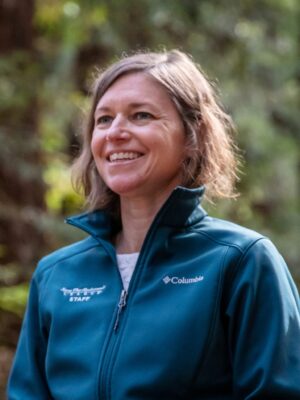
Jessica Carter
Senior Program Director
Jessica Carter’s career is grounded in the importance of outdoor access for our collective wellbeing. She joined Save the Redwoods League as director of parks and community engagement in 2018 after spending a decade with the National Park Service. There, she served as chief of business management at Golden Gate National Recreation Area, growing partnerships to enhance visitor access and community programs. She also led partnership development for a $38 million Alcatraz embarkation site and visitor welcome center.
Read more »
“I’ll never forget the first time I went to Muir Woods National Monument after starting my job with the National Park Service. Being surrounded by the majestic redwoods in the deep quiet of the forest was powerful,” says Carter.
Carter received her M.B.A. in Strategic Management, Sustainability/Corporate Social Responsibility from the University of California, Davis and her B.A. in Sociology from the University of California, Berkeley. Her expertise in managing nonprofit, commercial, and interagency partnerships helps the League expand and improve redwood parks and deliver resonant access, interpretation, and education programs. She oversees this integrated approach to redwoods access on key properties currently owned by the League, including ‘O Rew, Alder Creek, and Harold Richardson Redwoods Reserve.
Carter’s work engages communities that have historically been underrepresented in the conservation movement and that have faced barriers to enjoying parks and nature. By closely collaborating with park agencies, Tribes, and diverse communities, Carter helps the League provide meaningful opportunities to connect with the redwoods.
“As the world becomes increasingly diverse and complex, everyone deserves the chance to experience redwood forests because people have always been an integral part of the redwoods ecosystem,” says Carter. “Bridging equity gaps not only serves conservation, but also plays a key role in the wellness and prosperity of our society at large. Fostering inclusive and inspiring experiences in the outdoors is foundational to the League’s mission.”
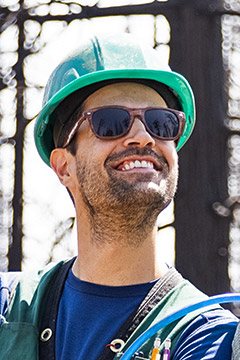
Anthony Castaños
Senior Land Stewardship Manager
As land stewardship manager for Save the Redwoods League, Anthony Castaños oversees all the League’s held properties and conservation easements, which are scattered throughout California’s redwood range from the Oregon border to Big Sur. Castaños develops and manages stewardship and ecological restoration projects across more than 50,000 acres, including properties like the Harold Richardson Redwoods Reserve and San Vicente Redwoods. He is often out in the forest, monitoring restoration work, seeking grant funding for these projects, and helping restoration teams address an evolving understanding of what it takes to preserve land.
Read more »
The scope and intensity of wildfires in recent years is the driving motivation for his land stewardship work. The biggest focus is on fuels reduction—crews in the forest doing the time-consuming but necessary work of thinning small trees and removing “ladder fuels” that carry fire up trees to the canopy. The thinning work is followed up by prescribed burning to consume the remaining fuel load on the forest floor.
The most challenging part of Castaños’ work is finding the right conditions for prescribed burns. “While fire always has inherent risks, conducting prescribed burns as safely as possible means working under optimal conditions, such as the right weather and winds,” says Castaños. The right partners are also essential; during a successful burn in 2024 at the Harold Richardson Redwoods Reserve, Castaños collaborated with the local tribe and community members. “It really helps to work with local crews so we can remain flexible and respond quickly when the conditions align.”
Castaños earned a B.A. in Urban Studies from the University of California, Berkeley.
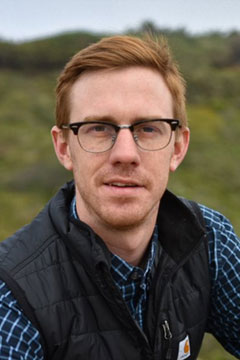
Mitchell Hayes
Partnership Manager
Mitchell Hayes grew up in Santa Cruz County, on the southern end of the redwood range. After receiving a B.S. in Project Management from California State University, Chico, he spent several years working in park and campground operations, including seasonal appointments with Placer County and California State Parks. Eager to apply his skills to protecting natural resources, he went back to school, earning an M.B.A. in Strategic Sustainability from Cal Poly Humboldt before joining Save the Redwoods League as project manager in 2021.
Read more »
“A huge component of my job is ensuring long-term success for Redwoods Rising, with both the partners and funders of the project,” says Hayes. “I do this by providing financial recommendations to partners, aligning funding needs, and navigating the complex contracting structure of the project.”
The restoration work coordinated under Redwoods Rising is aimed at rehabilitating crowded second-growth forests, restoring streams, and removing the many miles of abandoned logging roads to improve forest health and habitat.
“It’s gratifying to be part of a transformation, as forests that were exposed to clearcutting practices are restored back to good health,” says Hayes. “And knowing, too, that old-growth forests help with carbon sequestration, and that restoration work helps increase wildfire resilience and provides socioeconomic benefits to the North Coast. Sharing this knowledge and keeping such a large-scale project moving is one of the most important parts of my job.”
Currently, about $80 million in public funds has been committed to Redwoods Rising. Hayes is tasked with planning and tracking budgets with all the granting agencies. His natural proclivity for understanding different points of view makes him particularly well-suited as the administrator of this complex collaborative partnership.
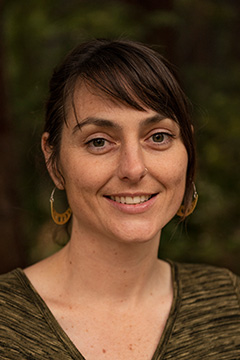
Laura Lalemand
Senior Scientist
Laura Lalemand’s love for the outdoors led her to earn a B.S. in Biology from the University of Maine at Farmington. After graduating, she took a position as a biological science technician with the U.S. Geological Survey. There she worked on projects focused on tree growth, mortality, drought response, and restoration in forests across the Sierra Nevada, northern California, and southern Oregon. She went on to earn an M.S. in Forestry from Humboldt State University.
Read more »
Lalemand joined Save the Redwoods League as a forest fellow in 2016 and was later hired as a forest ecologist in 2018. She is now the senior scientist on the League’s Science team.
“Through our science programs and initiatives, we conduct and collaborate on a wide range of redwood research across the range,” says Lalemand. “This research is critical to better understanding redwood forests and guiding our conservation, restoration, and stewardship activities. I find this work incredibly meaningful and increasingly important as climate change, wildfires, and other emerging threats continue to impact redwood forests.”
Lalemand has contributed to research on several forest studies, including: the impacts of controlled burning on western forests; coast redwood drought response following restoration; and the long-term dynamics of pitch pine forests in Maine. She currently serves on the board of the Humboldt County Prescribed Burn Association, the first such organization in California. At the League, she deeply appreciates how her job allows her to contribute to an all-encompassing vision of conservation.
“The League is working toward a convergence of forest conservation, restoration, and land stewardship, and I find that incredibly exciting,” she says. “We’re not just working to restore and maintain redwood forests. We’re working to conserve all the associated species that depend on redwood ecosystems. We’re integrating in-stream aquatic restoration, road removal and soil stabilization, forest restoration—everything that affects redwood ecosystems. And we’re doing it as an equal partner with other agencies and groups, collaborating to define and sustain our long-term mission.”

Steve Mietz
President and CEO
Steve Mietz holds an M.S. in environmental studies from the University of Montana and a B.S. from Cornell University. Before becoming president and CEO of Save the Redwoods League, Mietz garnered more than two decades of executive leadership and natural and cultural resources management experience across numerous national parks and recreational areas. His assignments included Redwood National and State Parks, Point Reyes National Seashore, Grand Canyon National Park, Pearl Harbor National Memorial, Great Basin National Park and multiple regional directorships around the American West.
Read more »
During his time as superintendent of Redwood National and State Parks (RNSP), Mietz partnered with Save the Redwoods League and California State Parks to establish and lead Redwoods Rising, an unprecedented public-private partnership to accelerate the pace and scale of restoration work across 70,000 acres of previously logged redwoods parkland. He also helped craft a first-of-its-kind agreement to establish a southern gateway to RNSP that the parks will co-manage with the Yurok Tribe on a property that the League will convey to tribal ownership in 2026. Mietz was named Superintendent of the Year for Natural Resource Stewardship by the National Park Service in 2022 for going above and beyond in protecting RNSP’s natural resources.
“My entire career has built to this crescendo—leading Save the Redwoods League,” says Mietz. “I’m honored and thrilled to carry forward the League’s mission to protect and restore these extraordinary redwood forests for future generations. Building on more than a century of conservation leadership, I’m excited to bring innovative and entrepreneurial approaches to meet today’s challenges, seize new opportunities, and inspire a new generation of forest stewards to help revive the redwood range.”
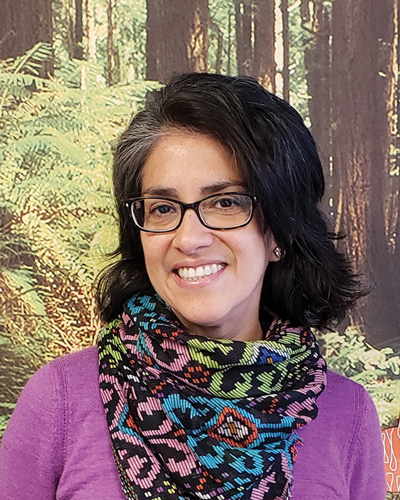
Leslie Parra
Senior Manager of Community Engagement
Leslie Parra has achieved recognition for her leadership in community civic action, STEM and environmental education, and DEI initiatives for over 15 years. Her professional calling is building enrichment programs with multicultural perspectives to expand inclusive public access to nature for all.
Read more »
As Save the Redwoods League’s senior manager of community engagement, Parra ensures that people of all backgrounds can not only benefit from the outdoors but also feel welcome in the natural spaces many take for granted. Immediately after joining the League, Parra began cultivating relationships with community groups and tribes to understand their interest in the redwoods. Since then, she has led the League’s strategic outreach to forge relationships and programmatic partnerships with community-based organizations, public lands managers, and leaders within these diverse networks to connect them to coast redwood and giant sequoia forests.
“I’ve learned that good things always happen when the community expands,” says Parra. “When we grow the community around redwoods, it will benefit not only those who have been historically excluded, but also the parks and trees themselves.”
During the COVID-19 pandemic, Parra launched the League’s podcast “I’ll Go If You Go,” which features diverse conservation and outdoor recreation leaders. The series strives to build community through conservation while promoting redwood access for all. Parra continues to serve as executive producer. She also helps communities connect with local redwood parks through the Redwood Rides access program and in collaborative enrichment projects.
“When you’re trying to build relationships with new audiences, it’s important to get out of your comfort zone and go where they are,” says Parra. “Sticking to the old ways of doing things is how conservation organizations lost their trust with these communities in the first place.”
Parra earned a B.S. in Zoology from North Carolina State University and a M.S. in Biology from San Francisco State University. She also received the 2025 Community Partnership Award for Campus Collaboration from San Francisco State University and the Institute for Civic and Community Engagement in recognition of her outstanding contributions to the university and the broader community.
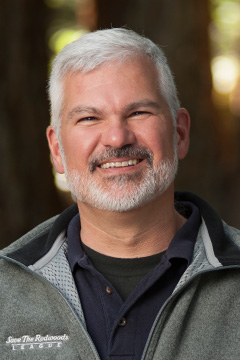
Paul Ringgold
Chief Program Officer
Paul Ringgold has been an outdoor enthusiast his entire life and has worked in conservation and land management for more than 30 years. As the League’s chief program officer, he oversees all land protection, stewardship, and forest restoration programs; public funding and policy engagement; park support; and education and interpretive programs. He also establishes specific priorities for the breadth of the League’s programs.
Read more »
“When I went on a hike through the ancient redwood forest at Prairie Creek Redwoods State Park about 10 years ago, it somehow crystallized my priorities,” says Ringgold. “I remember imagining how happy I’d be if I could find a way to help preserve forests like these. It made me realize what I really wanted to do with the rest of my career.”
Prior to joining the League, Ringgold served as vice president of Land Stewardship for the Peninsula Open Space Trust, a forest policy analyst for the Pinchot Institute of Conservation, and a forest manager and research program director for the University of Washington.
Ringgold holds a master’s in Forest Science, Forest Policy and Rural Sociology from Yale University and a B.S. in Forest Resources Management from the University of Washington. In addition to his work at the League, he serves on the Boards of the California Council of Land Trusts.
“Ultimately, the restoration and ongoing preservation of the coast redwood and giant sequoia forests throughout their ranges remains the League’s immutable goal,” says Ringgold. “We must continue to adapt and evolve our approach to the challenges of the coming century, especially as we expand our purview to meet the challenges of climate change and accelerating natural resource demands.”
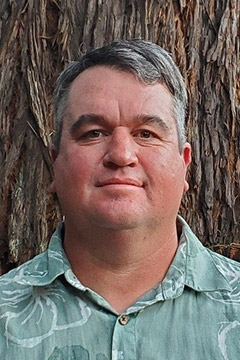
Spencer Stiff
Redwoods Rising Field Operations Manager
Spencer Stiff knows the forests and streams of California’s North Coast intimately. He grew up near Willits, California, at the edge of the redwood belt, and earned a B.S. in Freshwater Fisheries from Cal Poly Humboldt in 2002. Before joining Save the Redwoods League in 2021, Stiff explored a diverse career as a fish biologist, hatchery manager, roads superintendent, and logging contracts administrator. During his many years with Green Diamond Resources Company, Stiff focused on road management and ensuring logging operations did not negatively impact fish and their habitat.
Read more »
“I was really interested in doing large-scale watershed restoration—fully restoring these streams, removing old roads, and getting the crowded forests thinned back and into a healthy state,” says Stiff. “These measures help reduce the chance of catastrophic wildfires and recreate old-growth forest conditions.”
Stiff’s role with the League also enables him to spearhead work improving conditions for fish in redwood ecosystems. He oversees the decommissioning of former logging roads that haven’t been used in decades, which stems soil erosion that can cloud creeks.
“A lot of these streams were completely buried by old roads and crossings,” says Stiff. “Unearthing these waterways and removing the fill material will allow gravel to move down the creeks into larger streams, where they can provide high-quality spawning and rearing habitat for salmon and other fish.”
Stiff is also implementing aquatic restoration projects, working with contractors to place whole logs with intact “root wads” into streams, where they can help slow the movement of water and create ideal habitat for young fish to thrive among the redwoods.
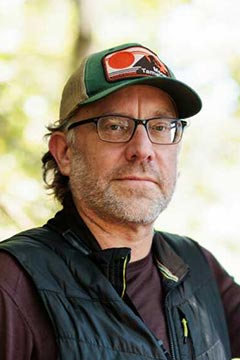
Jeff Stump
Director of Land Protection
With more than three decades of expertise in land conservation, stewardship, and policy development, Jeff Stump brings a wealth of knowledge and passion to his role at Save the Redwoods League. As the director of the League’s land protection team, he maintains a portfolio of priority acquisition projects while providing leadership to the talented staff that negotiate and finalize redwood forest acquisitions and conservation easements, ensuring the continued protection of vital redwood ecosystems.
Read more »
Stump holds a B.S. in Environmental Policy Analysis and Planning from the University of California, Davis. His areas of expertise include conservation programs, land conservation funding, fee title acquisitions, conservation easements, and leading high-functioning teams.
Stump’s contributions to the League have been significant, taking on some of the organization’s most public-facing and challenging projects. His recent work includes the protection of Monte Rio Redwoods and Russian River Redwoods in Sonoma County, crafting an agreement to acquire Sonoma Coast Redwoods, and working with Mendocino Redwoods Company on the Dark Gulch acquisition at Montgomery Woods. He is currently supporting the transfer of the ‘O Rew property to the Yurok Tribe, working to resolve access and water issues at the League’s Alder Creek property, collaborating with California State Parks to transfer several properties into their ownership, and working to secure new opportunities for redwood land protection at scale.
Before joining the League in January 2022, Stump served as the director of conservation at the Marin Agricultural Land Trust (MALT). He directed their easement acquisition and stewardship programs, provided strategic guidance on conservation priorities, and developed policy and funding models at local, state, and federal levels to support land conservation and stewardship. His efforts at MALT contributed to the protection of 29 family farms and ranches, covering more than 16,250 acres.
Stump’s career also includes significant roles at the American Land Conservancy, where he handled some of the organization’s most complex land transactions—including protection of the Hearst Ranch—and at the California Coastal Commission, where he was the Commission’s legislative liaison. He has served on the board of the Marin Conservation League for six years, the Marin Carbon Project’s steering committee, and contributed to the Bay Area Critical Linkages Project, now part of the Conservation Lands Network.
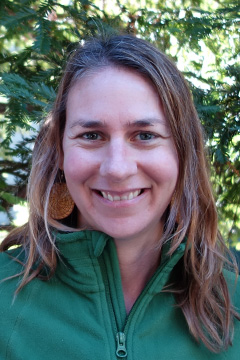
Deborah Zierten
Senior Manager of Education and Interpretation
Protecting, connecting and rejuvenating the redwood forests demand ample hands-on work, but the process is predicated on hearts and minds. Unless people understand the significance of redwood conservation, they won’t support the projects forest restoration requires. “The best way to reach adults with our message is to inspire them when they’re children,”
Read more »
Zierten’s mission, then, is educational outreach, both in the schools and the redwood parks.
“We need to do both,” she observes. “The schools offer our best opportunity for replicable programs across the entire redwood range. For high schools, we provide a redwood forest program that ties into climate change and carbon sequestration. Our curricula are locally focused, so that kids can conduct hands-on research almost literally in their backyards.”
The League also has an elementary school program, Explore Your Watershed, Zierten says.
“We take students on field trips to redwood forests in the upper reaches of their local watershed and to the San Francisco Bay,” she says. “They’re taught how it all is connected, and how the health and integrity of the coast redwood forest can ultimately affect water quality in the Bay. For many of these kids, our field trips provide their first visit to a forest. It’s incredibly moving to watch them becoming engaged with the redwoods, to see them explore the connections between critical natural systems.”
Such youthful enthusiasm is infectious, Zierten notes, and that’s an essential factor in redwood conservation outreach.
“A truism in this work is that you teach the kids to reach the parents,” Zierten says. “When your kids develop an intense interest, you inevitably end up sharing it.”
Zierten also provides professional development to docents in California’s redwood parks to inform them of the latest findings in redwood research
“The parks, of course, are the best possible venues for educating people about the redwood forest,” Zierten says. “Park visitors are already in a receptive frame of mind – they want to know more about the redwood forest, and what they can do to protect it. We want to make sure there are people on the ground who can answer their questions, enhance their experiences and engage them directly in redwood conservation.”
Part of that task involves direct training of docents and park staff, “we also ensure that the parks have access to the tremendous body of research produced by League scientists,” says Zierten. “We help the parks find innovative ways to communicate about redwood conservation with the public.”
Zierten grew up in Oakland and spent much of her free time exploring the expansive redwood parks of the East Bay. She earned her Bachelor’s degree in biology at the University of Oregon and her Master’s degree in environmental education at Southern Oregon University.
“I love Oregon,” she says, “but I’m glad to be back in the Bay Area. The redwood forest is where I feel most at home and where my heart is.”